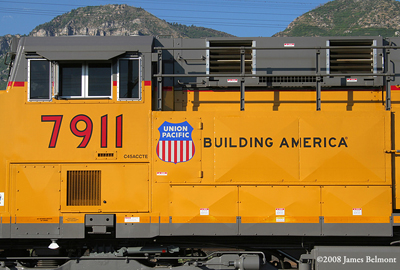Union Pacific Colors on the Web
This page was last updated on January 7, 2015.
(Return To UP Paint Index page)
Back in August 2000 I sent an email to UP's webmaster asking them how they simulated UP's unique Armour Yellow color for their web pages. Here is their response:
The RGB value (0-255 scale) we use is:
R:255 G: 204 B: 0
or a hexidecimal number of FFCC00.
The colors on locomotives are Armour Yellow and Harbormist Gray.
If you were to take the actual paint sample and did a color spectrograph of the paint to exactly match RGB or ink color you would be disappointed. The "real" Armour Yellow is actually a mustardy-chartreuse color that would look sickly on the calender photos or on a Web site. When locomotives are in the sunlight on the tracks, our eyes "correct" the yellow and they appear more how we visualize them in photographs.
The RGB color we specify is actually the closest pleasing color that is among the 216 Web-safe colors that all browsers will display without dithering (adding red speckles).
As a point of trivia, our first homepage design as it was intended to appear in December 1995 was going to have this yellow background. This page design was so powerfully oppressive due to the overwhelming yellow that the color was dropped before it site was released. We use it on our site today in small doses against the "Diesel Gray" and "Harbormist" colors.
Just a thought as you develop your pages.
UP recommended colors:
| 255-204-0, FFCC00 | 102-102-102, 666666 | 209-0-0, D10000 |
Using the free OpenRGB calculator, and depending on your monitor, the colors may vary slightly from those used by UP eight years ago.
Changing the R value to anything less than 255 really changes the look immediately.
Changing the G value seems to have the most effect.
Changing the B value to anything between 0 and 100 does not seem to change the overall color.
Here are some samples of "Armour Yellow":
| 255-204-0, FFCC00 | 255-212-0, FFD400 | 255-224-0, FFDE00 |
For "Harbormist Gray", try these, keeping in mind that perfect grays are always equal in their RGB values:
| 91-91-91, 5B5B5B | 95-95-95, 5F5F5F | 97-97-97, 616161 |
Holding a Union Pacific Color Control Standard (1979) up to the computer screen, and adjusting the colors as closely as possible (in single digits in OpenRGB), the resulting (imperfect) colors are also noted.
Note: Comparing a color sample to a computer screen is not a very accurate way to match colors, i.e. frontlit sample vs. backlit computer screen.
| UP color card 224-168-0, E08A00 |
UP color card 99-95-86, 635F56 |
UP color card 191-16-20, BF1015 |
Dick Harley picked the following colors from a color wheel:
| 254-189-0, FEBD00 | 134-134-134, 868686 | 254-0-0, FE0000 |
Many observers have noted that UP's colors changed with the adoption of EPA-friendly paints in the 1990s. For the most recent colors, take a look at this recent photo by James Belmont, of freshly delivered UP 7911 at Provo on July 30, 2008. Using an average of values calculated by Photoshop, we get the following:
| 232-155-35, E89B23 | 112-112-112, 707070 | 200-30-35, C81E23 |

Obviously there are some differences, but my own choices for UP colors of the 1950s and 1960s would be these, but they will look different on different computers:
| 254-189-0, FEBD00 | 99-95-86, 635F56 | 209-0-0, D10000 |
...properly stacked, they look like this:
| 99-95-86, 635F56 |
| 209-0-0, D10000 |
| 254-189-0, FEBD00 |
| 209-0-0, D10000 |
| 99-95-86, 635F56 |
Fiddle with the colors; tweak the numbers; find the one you like best. OpenRGB makes this really easy.
###